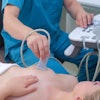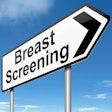Using a two-tiered computer-aided detection (CAD) scheme may cut down on breast cancer cases in which an ultimately true-positive CAD marker was discounted during interpretation, according to researchers from New York.
"Not all prompts from CAD represent true positives, but this study shows that the small population of (true-positive) CAD markings that mammographers may potentially want to discount can be salvaged if we use a more sophisticated model which (provides data on) what level of suspicion the CAD system has," said Dr. Shalom Buchbinder of Staten Island University Hospital in New York City. Buchbinder presented the study results at the 2005 RSNA meeting in Chicago.
The group conducted a retrospective blinded study to assess the performance of a CAD classification scheme on previously overlooked cancers that were detected by CAD but considered nonactionable by the mammographers, Buchbinder said. The 366 malignancy cases were contributed by three clinical sites.
The cases included prior mammograms obtained nine to 24 months prior to the mammogram that led to the cancer diagnosis. The prior cases were reviewed first by two nonblinded radiologists, who independently compared the current and prior mammograms. From the review, 253 cases were judged to have lesions considered visible to some extent on the prior mammogram.
The 253 prior mammograms with visible lesions were processed by the detection tier of a CAD device in order to detect suspicious findings. In 136 cases, the suspicious lesions were CAD-detected, Buchbinder said. The research was performed using CAD technology from Siemens Medical Solutions (Malvern, PA) that has not yet been approved by the Food and Drug Administration.
The 136 prior mammograms with CAD-detected lesions were randomly mixed with 136 normal mammograms, and three independent blinded radiologists retrospectively analyzed the 272 mammograms, knowing they were interpreting an enriched case mix.
Of these cases, 53 lesions analyzed retrospectively were considered nonactionable, since either none or only one of the three blinded radiologists marked the suspicious lesion and deemed it actionable.
The researchers then sent those 53 images through a classification tier of the CAD system to assess the level of suspicion. The computerized classification scheme correctly classified 47 of the 53 (87%) images with a high level of suspicion. In four cases, the classification scheme yielded a low level of suspicion, and in two cases an intermediate level of suspicion was returned.
Twenty-eight of the 33 masses were correctly classified, while 14 of the 15 clusters were correctly classified. All five masses that contained calcifications were correctly classified, Buchbinder said.
The use of classification capabilities "has the potential for improving the performance of the CAD system," he concluded.
By Erik L. Ridley
AuntMinnie.com staff writer
January 27, 2006
Related Reading
CAD results as evidence in Ohio trial may open the door to future rulings, January 4, 2006
Breast MRI CAD yields specificity gains, December 12, 2005
CAD falls short of double reading for breast cancer detection, October 25, 2005
Sharp rise in U.K. breast cancer survival rates, October 10, 2005
Breast cancer drug move gives hope to U.K. patients, October 6, 2005
Copyright © 2006 AuntMinnie.com




















